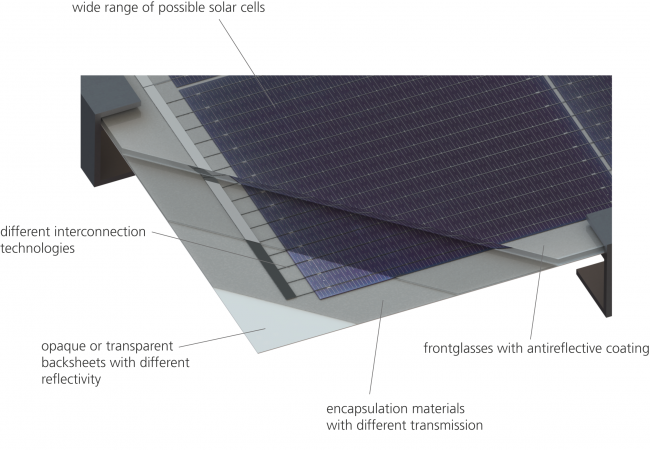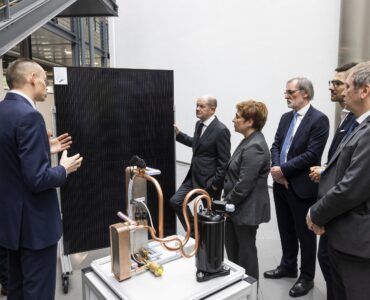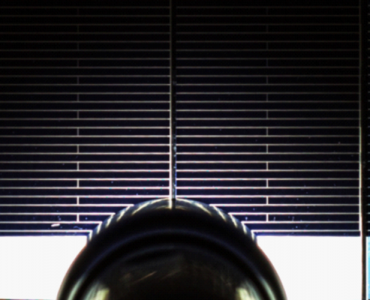A photovoltaic module consists of many interconnected solar cells. One cannot say, however, that the module power is simply the sum of the individual cells. Power losses due to reflection, absorption or electrical losses come about in the integration process. These cell-to-module, or CTM, losses have a large effect on the subsequent module performance and can vary greatly depending on the type of solar cell, material or module design. We at Fraunhofer ISE have created a model based on different material parameters in order to calculate these variations. With SmartCalc.CTM, we have developed a software program that makes PV modules (even) more efficient.
Over the past years, research and industry have put lots of know-how and effort in further developing solar cells. As a result, solar cell efficiencies have increased appreciably and costs have been greatly reduced. In order to make use of these advances in the practice, the integration of solar cells into PV modules must be optimized; modules must be resistant to environmental aging on the long-term and show low performance losses at the same time. In order to optimize the PV module assembly, the Group of Photovoltaic Modules at Fraunhofer ISE has developed software to assist manufacturers and material producers in the PV industry. The software allows different materials and components as well as their interaction to be analyzed in order to obtain the highest module performance possible.
From the Solar Cell to the Module: Interplay of Different Factors
The cell-to-module (CTM) losses and gains indicate the efficiency of the module integration. The CTM value is influenced by geometrical factors like unused module edge areas, optical factors such as reflection and absorption as well as electrical losses. Not only power losses but also gains are possible. Due to additional light reflected onto the solar cell or lower cell reflectivity, power outputs can be achieved that are even higher than initial solar cell measurements. For a module manufacturer who aims to achieve the highest PV module power possible, a detailed analysis and optimization of these influential factors can lead to appreciable increases in efficiency.
The factors influencing the module power can be broken down into physical mechanisms and the particular module components. This allows the potential for improvement to be detected easily and applied in practice. (See Fig. 1)

If the module materials, the basic module assembly or the solar cells are varied, then the CTM factors change, in part, drastically. When optimizing all factors, a well-chosen combination of materials and module concepts can even lead to a module power that is greater than the sum of its cells. A detailed CTM analysis is an important tool for module manufacturers who wish to improve their products and reduce module costs.
SmartCalc.CTM: User-friendly Analysis of Module Efficiency
In the group “Photovoltaic Modules” at Fraunhofer ISE, we have not only developed a detailed model to describe these factors but also implemented it in an user-friendly software. With SmartCalc.CTM (www.cell-to-module.com), it is possible to perform a complete and detailed analysis of the gain and loss factors in solar modules. The graphic interface allows users not only to evaluate the effect of new materials on the module power but also to analyze completely new module concepts – even before the first prototype is manufactured.
The software allows the easy adaption of solar cells, encapsulation materials or module glazings, enabling the influence of new materials on the module efficiency to be evaluated. New technologies can also be investigated with the software, for example half solar cells, round-wire cell connectors or conductive adhesives instead of conventional soldering techniques. The scientific principles behind SmartCalc.CTM are detailed and flexible, allowing new module techniques to be investigated.

An illustrative example: A module manufacturer would like to further develop a product. An analysis of the CTM factors has already been carried out (See Figure 1). The manufacturer is considering the implementation of half solar cells and glass-glass lamination for the module. Within minutes, SmartCalc.CTM provides the manufacturer with a detailed analysis of his future options. The simulation results show that the power increase for the new product would be only 1.0 Wp (+0.3%rel) pro module compared to his current product design.
What causes this change? When half cells are used, the total area between the cells, and thus the inactive module area, increases. This decreases the module efficiency, yet increases the module power since the white back sheet foil reflects additional light onto the solar cells. Because the manufacturer chose a glass-glass module, this power gain is unable to be realized. The light incident on the area between the cells goes right through the module and is not reflected internally. The use of half cells, however, leads to less electrical losses. The smaller cell area reduces the area-dependent current, thus decreasing the resistance losses in the cell connectors by circa 75 percent. In all, the power gain is very small. Considering his material and production costs, the module manufacturer can however decide if a changeover would be worth it, since he would, for example, save the costs for the module frame. If the manufacturer also wants to make use of the reflective potential in the space between the half cells, he can apply a reflective foil or white encapsulation material behind the cells. Thus the advantage of using half cells can be fully transferred to the module power.
The profit and loss factors vary depending on the materials and module concepts used. The software we developed helps to identify the significant factors, enabling a goal-oriented optimization. This saves the manufacturer time, reduces the development costs and shows the potential for efficiency increases.
SmartCalc.CTM and the underlying scientific models are being continually developed and verified at Fraunhofer ISE. We are able to analyze new technologies such as innovative solar cells or module concepts within minutes, with model results varying by +/-2 percent compared to measurements. Since the models are based on only a few material parameters and input values, new materials can be rapidly investigated: We first measure the material characteristics and import them into the tool. With a few mouse clicks, we then can determine its effect on the module power.
For our research and development work at Fraunhofer ISE, SmartCalc.CTM is already an indispensable tool. We use the tool to prepare and evaluate experiments, analyze new technologies, improve existing modules or in cooperative work with the quality and assurance department of our partners.




Add comment